Skype: neodalle-travel
Tel: +86 135 7447 2266
E-mail: sales@visitaroundchina.com
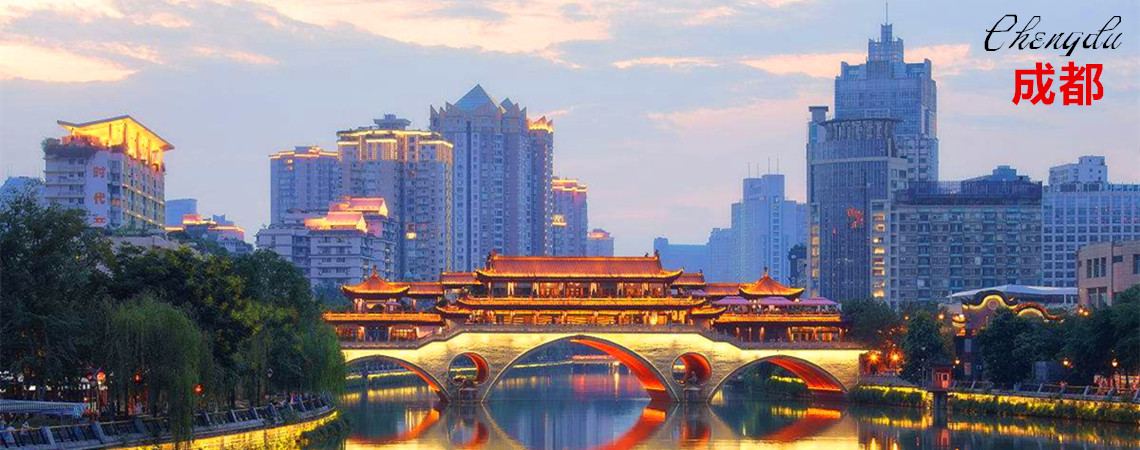
What to see?
Dujiangyan Irrigation System
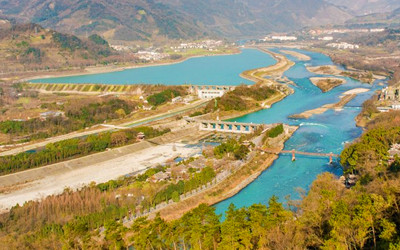 The project consists of three important parts, namely Yuzui, Feishayan and Baopingkou scientifically designed to automatically control the water flow of the rivers from the mountains to the plains throughout the year.
The project consists of three important parts, namely Yuzui, Feishayan and Baopingkou scientifically designed to automatically control the water flow of the rivers from the mountains to the plains throughout the year.
Yuzui, like a big fish lying in the Minjiang River, is a watershed dividing the river into two parts: inner river and outside river. Feisha Yan is a spillway that diverts the sand and stones of the inner river into the outer river. Baoping Kou, like a neck of a bottle, is used to bring water into the inner river from Minjiang. At the same time, Baoping Kou controls the amount of the intake water due to its reasonable location. These three parts interact with each other perfectly to form an effective water conservancy project. During the low-water season, 60% of the Minjiang water is brought into the inner river for irrigation while 40% of the water is drawn into the outside river. The situation is reversed in the flood season ensuring the water supply for irrigation and protection from flooding on the Chengdu Plain.
Two Kings Temple
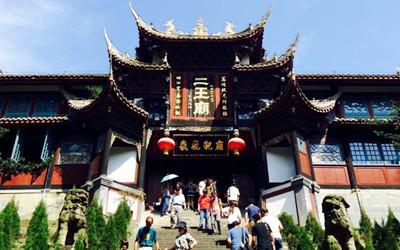 Two Kings Temple is located in the Minjiang River right bank slope; it closes to Dujiangyan in the front. It was Emperor Temple originally for memory of the king of Shu, and in Qi dynasty Jianwu period (A.D. 494-498) it was offered sacrifices to Libing and his son, renamed the "Chongde Temple". After the Song dynasty (960-1279), Liing and his son have been knighted as king successively, so the temple was called "Two Kings Temple". In the main hall, there is the statue of Libing and his son, and there was water conservancy quotes, poet inscriptions and so on. The building group distributes in eastern Dujiangyan Irrigation System with large-scale, rigorous layout. It covers an area of about 50000 square meters, the main building about 10000 square meters. Two Kings Temple divided into east and west garden, east garden is landscape garden, west garden is for temple area.
Two Kings Temple is located in the Minjiang River right bank slope; it closes to Dujiangyan in the front. It was Emperor Temple originally for memory of the king of Shu, and in Qi dynasty Jianwu period (A.D. 494-498) it was offered sacrifices to Libing and his son, renamed the "Chongde Temple". After the Song dynasty (960-1279), Liing and his son have been knighted as king successively, so the temple was called "Two Kings Temple". In the main hall, there is the statue of Libing and his son, and there was water conservancy quotes, poet inscriptions and so on. The building group distributes in eastern Dujiangyan Irrigation System with large-scale, rigorous layout. It covers an area of about 50000 square meters, the main building about 10000 square meters. Two Kings Temple divided into east and west garden, east garden is landscape garden, west garden is for temple area.
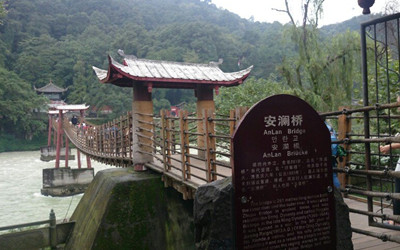 Anlan Rope Bridge also known as "Anlan Bridge", "Couple Bridge". It is located in Dujiangyan Fish Mouth, across both inside and outside two rivers, known as the one of the "five bridges of ancient China", is the most typical landscape of Dujiangyan. It was built in the Song dynasty, and in the late Ming dynasty (17th century AD) it was destroyed by war. Its ancient name is “Zhupu Bridge”, in the Song dynasty of the first year of Chunhua period, it was changed to "Pingshi Bridge", and in the Qing dynasty emperor Jiaqing built a new bridge and renamed "Anlan Bridge". The original bridge used wood block as base, hanging a thick bamboo cable cross the river, and there are planks as bridge deck. On both sides of bridge are bamboo rope railings, total length of about 500 meters.
Anlan Rope Bridge also known as "Anlan Bridge", "Couple Bridge". It is located in Dujiangyan Fish Mouth, across both inside and outside two rivers, known as the one of the "five bridges of ancient China", is the most typical landscape of Dujiangyan. It was built in the Song dynasty, and in the late Ming dynasty (17th century AD) it was destroyed by war. Its ancient name is “Zhupu Bridge”, in the Song dynasty of the first year of Chunhua period, it was changed to "Pingshi Bridge", and in the Qing dynasty emperor Jiaqing built a new bridge and renamed "Anlan Bridge". The original bridge used wood block as base, hanging a thick bamboo cable cross the river, and there are planks as bridge deck. On both sides of bridge are bamboo rope railings, total length of about 500 meters.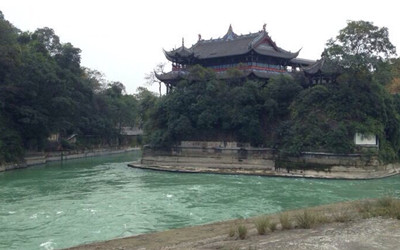 Fulong Temple is located in the Lidui Park. Below is the Linshen Pool, it is said that when Libing and his son were here to prevent floods by water control, they subdued evil dragon under the Lidui, so in the early years of the northern Song dynasty in order to memory Libing, named "Fulong Temple" (means subdued dragon in Chinese). In the middle of front hall there is Libing stone figure carved in the eastern Han dynasty (25-220 AD). Inside the hall, there are also weir workers statues of the eastern Han dynasty, Tang dynasty relic that Jinxian and Princess Yuzhen cultivated themselves according to a religious doctrine in Mount Qingcheng – Flying Dragon Ding (an ancient cooking vessel with two loop handles and three or four legs). Fulong Temple is also named Laowang Temple, Li Ancestral Temple, Li Temple, etc.
Fulong Temple is located in the Lidui Park. Below is the Linshen Pool, it is said that when Libing and his son were here to prevent floods by water control, they subdued evil dragon under the Lidui, so in the early years of the northern Song dynasty in order to memory Libing, named "Fulong Temple" (means subdued dragon in Chinese). In the middle of front hall there is Libing stone figure carved in the eastern Han dynasty (25-220 AD). Inside the hall, there are also weir workers statues of the eastern Han dynasty, Tang dynasty relic that Jinxian and Princess Yuzhen cultivated themselves according to a religious doctrine in Mount Qingcheng – Flying Dragon Ding (an ancient cooking vessel with two loop handles and three or four legs). Fulong Temple is also named Laowang Temple, Li Ancestral Temple, Li Temple, etc.
Travel Tips
Add: In the Minjiang River, Dujiangyan city,west of Chengdu Plain, 56 km from Chengdu,China
Entrance Fee: CNY 90
Opening Hours: March 2 to November 30: 08:00 - 18:00; December 1 to next March 1: 08:00 - 17:30
 Ask Questions ?
Ask Questions ?